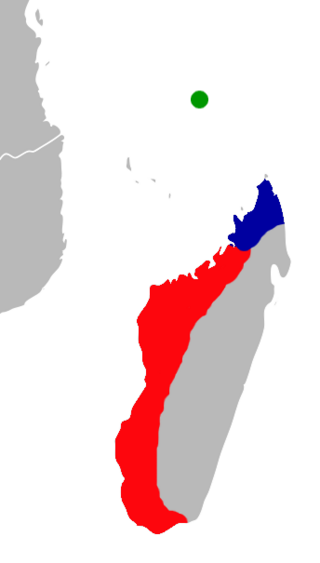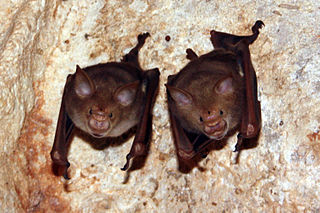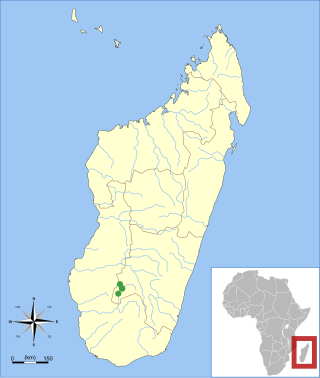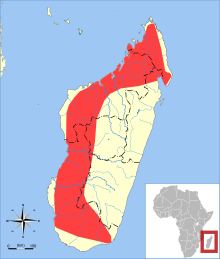
The lesser yellow bat is a vesper bat found only on Madagascar and Réunion. On Réunion, it was considered common early in the 19th century, but was last sighted late in the 19th century. Only a single specimen attributed to this species, collected in 1868, is known from Madagascar. It was listed as a critically endangered species in 1996 due to habitat loss, and may be extinct.

The rufous trident bat, Persian trident bat, or triple nose-leaf bat is a species of bat in the genus Triaenops. It occurs in southwestern Pakistan, southern Iran, the United Arab Emirates, Oman, and Yemen. In the last country, it occurs together with the much smaller Triaenops parvus. Populations from Madagascar and mainland Africa have also been assigned to T. persicus, but are referable to the species Triaenops menamena and Triaenops afer, respectively. Madagascar populations have also been referred to as Triaenops rufus, but this name is a synonym of T. persicus.

Peters's wrinkle-lipped bat, also called Peters's goblin bat, is a species of bat in the family Molossidae, the free-tailed bats. It is endemic to Madagascar, where it is widespread and in some areas abundant. It commonly roosts in human-made structures, sometimes in colonies with other free-tailed bat species. It forages in the open, often in agricultural areas. The bat is sexually dimorphic, with males larger than females.

The Malagasy serotine, is a species of vesper bat. It is found only in Madagascar. It was formerly classified in Neoromicia before phylogenetic analysis found it to belong to Laephotis.

The Manavi long-fingered bat is a bat in the genus Miniopterus that occurs in east-central Madagascar. First described in 1906, this species was later included in the mainland African M. minor. A 1995 revision united populations of small Miniopterus from Madagascar and the Comoros as M. manavi, but molecular and morphological studies in 2008 and 2009 showed that this concept of M. manavi in fact included five different species. M. manavi itself was restricted to a few locations in the eastern Central Highlands and populations in the Comoros and northern and western Madagascar were allocated to different species.

The Madagascan fruit bat is a species of bat in the family Pteropodidae. It is endemic to Madagascar and is listed as "Vulnerable" by the IUCN because it is hunted as bushmeat.

Grandidier's trident bat is a species of bat in the family Hipposideridae endemic to Madagascar. It was formerly assigned to the genus Triaenops, but is now placed in the separate genus Paratriaenops.

Triaenops is a genus of bat in the family Rhinonycteridae. It is classified in the tribe Triaenopini, along with the closely related genus Paratriaenops and perhaps the poorly known Cloeotis. The species of Paratriaenops, which occur on Madagascar and the Seychelles, were placed in Triaenops until 2009. Triaenops currently contains the following species:

Paratriaenops furcula, also known as Trouessart's trident bat, is a species of bat in the family Hipposideridae. It is endemic to Madagascar. It was formerly assigned to the genus Triaenops, but is now placed in the separate genus Paratriaenops. A related species, Paratriaenops pauliani, occurs in the Seychelles.

The Hipposideridae are a family of bats commonly known as the Old World leaf-nosed bats. While it has often been seen as a subfamily, Hipposiderinae, of the family Rhinolophidae, it is now more generally classified as its own family. Nevertheless, it is most closely related to Rhinolophidae within the suborder Yinpterochiroptera.

Triaenops goodmani is an extinct bat from Madagascar in the genus Triaenops. It is known from three lower jaws collected in a cave at Anjohibe in 1996, and described as a new species in 2007. The material is at most 10,000 years old. A bat humerus from the same site could not be identified as either T. goodmani or the living T. menamena. T. goodmani is identifiable as a member of Triaenops or the related genus Paratriaenops by a number of features of the teeth, such as the single-cusped, canine-like fourth premolar and the presence of a gap between the entoconid and hypoconulid cusps on the first two molars. T. goodmani is larger than the living species of Triaenops and Paratriaenops on Madagascar, and on the first molar the protoconid cusp is only slightly higher than the hypoconid, not much higher as in the other species.

Pipistrellus raceyi, also known as Racey's pipistrelle, is a bat from Madagascar, in the genus Pipistrellus. Although unidentified species of Pipistrellus had been previously reported from Madagascar since the 1990s, P. raceyi was not formally named until 2006. It is apparently most closely related to the Asian species P. endoi, P. paterculus, and P. abramus, and its ancestors probably reached Madagascar from Asia. P. raceyi has been recorded at four sites, two in the eastern and two in the western lowlands. In the east, it is found in open areas and has been found roosting in a building; in the west it occurs in dry forest. Because of uncertainties about its ecology, it is listed as "Data Deficient" on the IUCN Red List.

The Isalo serotine is a vesper bat of Madagascar in the genus Laephotis. It is known only from the vicinity of the Isalo National Park in the southwestern part of the island, where it has been caught in riverine habitats. After the first specimen was caught in 1967, it was described as a subspecies of Eptesicus somalicus in 1995. After four more specimens were collected in 2002 and 2003, it was recognized as a separate species. Because of its small distribution and the threat of habitat destruction, it is considered "vulnerable" in the IUCN Red List.

Paratriaenops is a genus in the bat family Hipposideridae. It is classified in the tribe Triaenopini, along with the closely related genus Triaenops and perhaps the poorly known Cloeotis. The species of Paratriaenops were placed in Triaenops until 2009. Paratriaenops currently contains the following species:

Paratriaenops pauliani is a species of bat in the family Hipposideridae. It is endemic to Aldabra Atoll of the western Seychelles, where it was found on Picard Island. It was formerly considered to be part of the species Triaenops furculus, known from Madagascar, and was initially assigned as a new species within the genus Triaenops. Later it as well as T. furculus were placed in the separate genus Paratriaenops. A related species, Paratriaenops auritus, also of Madagascar, was similarly reassigned.

Commerson's roundleaf bat, also known as Commerson's leaf-nosed bat, is a species of bat endemic to Madagascar. It is named after French naturalist Philibert Commerson (1727-1773). Bat populations of Africa or São Tomé and Príncipe formerly considered part of this species are now classified separately as M. gigas, M. thomensis or M. vattatus, while one from Madagascar was split off to become M. cryptovalorona. It was formerly placed in the genus Hipposideros, but moved to the resurrected Macronycteris in 2017 on the basis of molecular evidence.

Mops jobimena, commonly known as the black and red free-tailed bat, is a species of bat in the family Molossidae. It is endemic to western Madagascar. With a forearm length of 45 to 48 mm,

The African trident bat is a species of bat found in Africa.

Rhinonycteridae is a family of bats, within to the suborder Yinpterochiroptera. The type species, the orange nose-leafed species group Rhinonicteris aurantia, is found across the north of Australia.



















